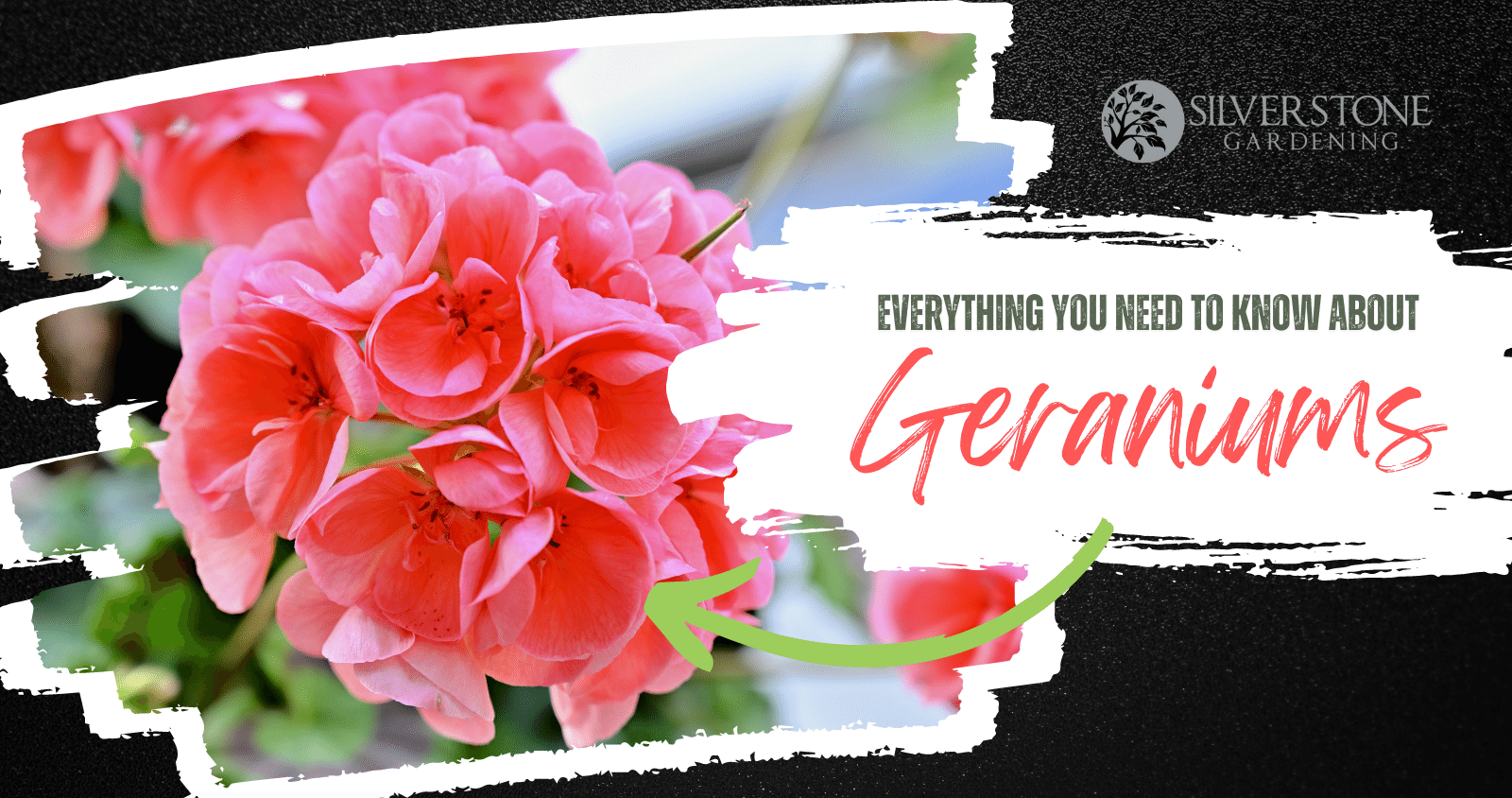
Geraniums, also known as Pelargoniums, are a popular species of flowering plants that are native to southern Africa. These perennials are known for their vibrant and colourful blooms, which come in a variety of shapes and sizes.
There are over 200 different species of geraniums, and they can be divided into several different groups based on their characteristics. The most common types of geraniums include the zonal, ivy-leaved, scented, and species geraniums.
Zonal geraniums
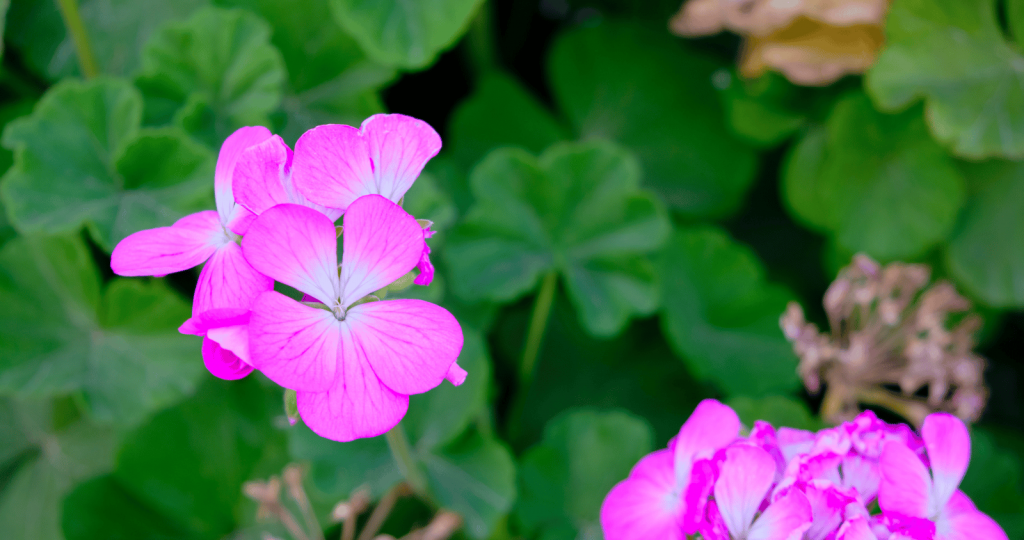
Zonal geraniums are the most popular variety, and they are known for their distinctive zone or band of colour around the edge of the leaf. These geraniums come in a wide range of colours including red, pink, white, and salmon. They can be grown as bedding plants or in pots, and they are often used in hanging baskets or window boxes.
Ivy-leaved geraniums
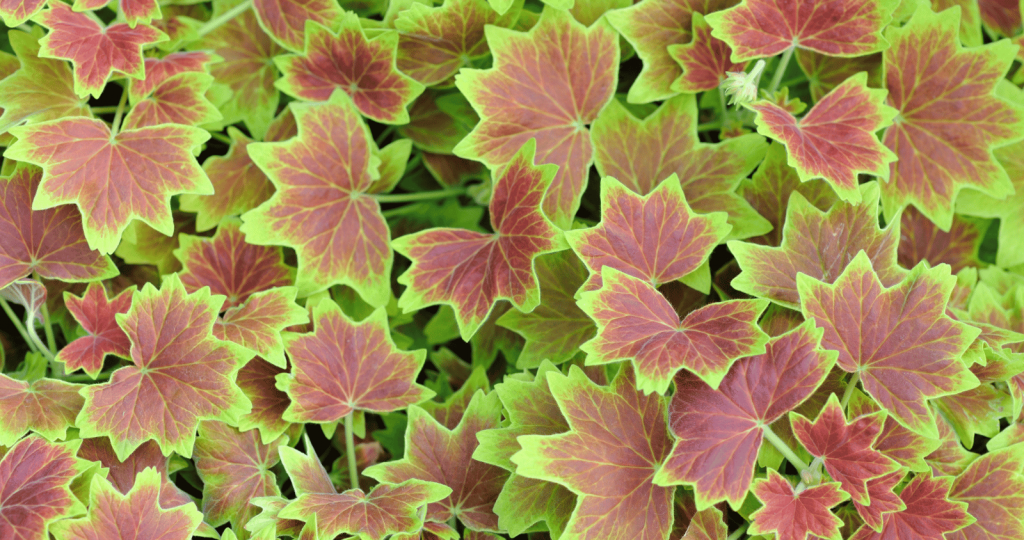
Ivy-leaved geraniums are another popular variety, and they are known for their trailing habit and ivy-shaped leaves. These geraniums are often used in hanging baskets or window boxes, and they come in a wide range of colours including red, pink, and white.
Scented geraniums
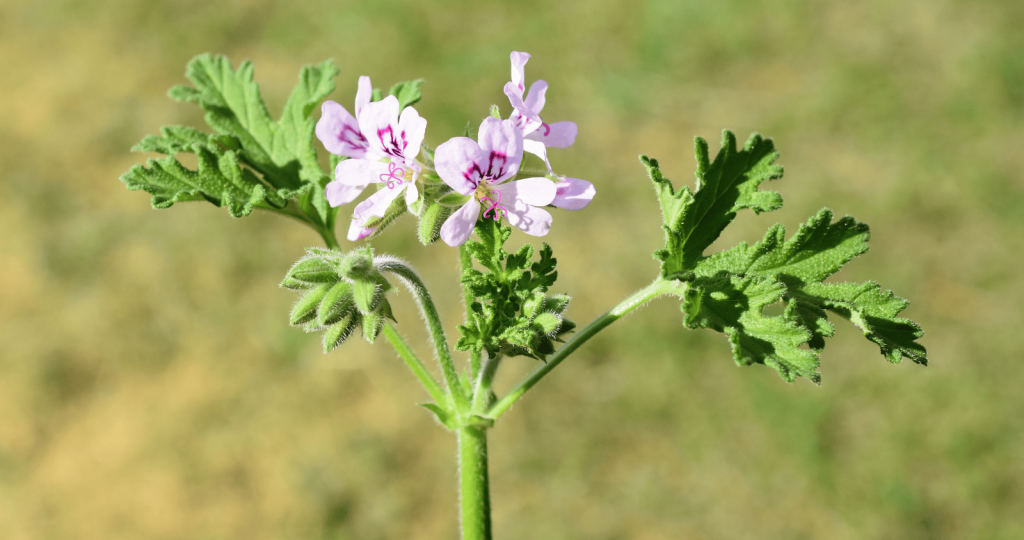
Scented geraniums are another type of geranium, and they are known for their fragrant leaves. These geraniums come in a variety of scents including lemon, rose, and mint. They are often used in perfumes and potpourri, and they are also popular in herb gardens.
Species geraniums
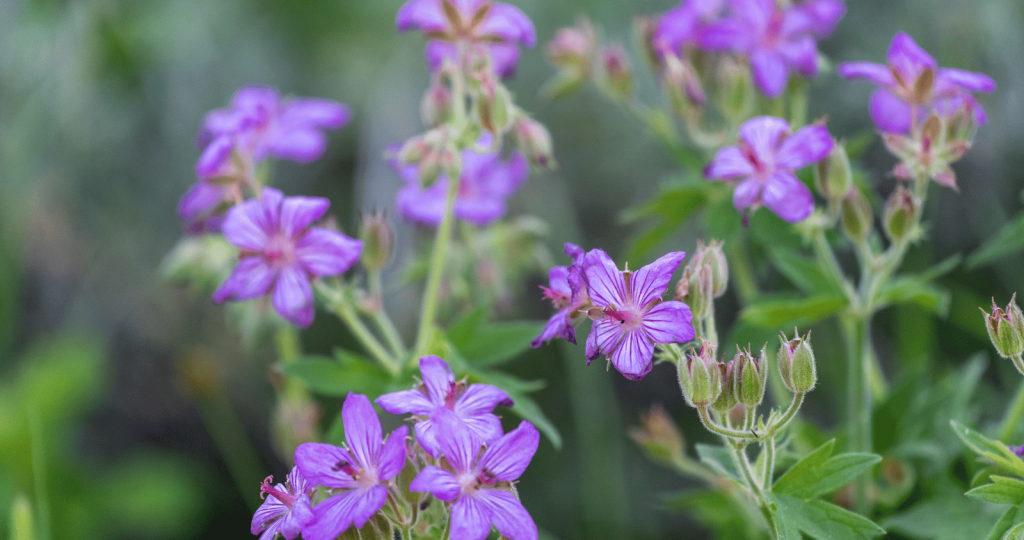
Species geraniums are the wild relatives of the cultivated geraniums. They are usually smaller in size and have smaller flowers, but they often have a longer blooming period and are more tolerant of poor soil and drought conditions.
Geraniums are hardy plants that are easy to grow and care for. They prefer well-drained soil and full sun, and they should be watered regularly. Geraniums can be propagated by taking stem cuttings in late summer or early fall. (We recommend using this rooting hormone to help root formation in your cuttings.)
What soil, sun and weather conditions do geraniums like?

Geraniums prefer well-drained soil that is rich in organic matter. They prefer a pH range between 6.0 and 7.0 (use this kit to find out your soil’s pH level), and they do not tolerate heavy clay soils. They prefer full sun to partial shade, and they will bloom best in areas that receive at least 6 hours of direct sunlight per day. Geraniums are not tolerant of extreme heat or cold, and they will not survive frost or freezing temperatures.
Geraniums also require regular watering, two watering days per week , to keep the soil consistently moist. It is better to be watered in the morning so the foliage has time to dry before evening which will help prevent fungal diseases. They also require regular fertilisation, especially during the growing season, to promote healthy growth and blooms. Geraniums are drought-tolerant to a degree, but prolonged dryness can cause the leaves to wilt and the plant to stop blooming.
In short, Geraniums prefer well-drained soil, rich in organic matter, with a pH range between 6.0 and 7.0. They prefer full sun to partial shade, and at least 6 hours of direct sunlight per day. They require regular watering and fertilisation, and they are not tolerant of extreme heat or cold.
How much water do geraniums need?
Geraniums a hardy plants but do require regular watering to keep the soil consistently moist. They typically need about two watering days per week through the hotter months to thrive. In some conditions they may need some additional hand watering.
It’s important to note that watering in the morning is the best time for geraniums as it allows the foliage to dry before evening. Overwatering or watering in the evening can lead to fungal diseases.
It’s also important to check the soil moisture regularly before watering, as over-watering can also lead to root rot and other issues. A simple way to check the soil moisture is by sticking your finger into the soil up to the first knuckle. If the soil feels dry, it’s time to water
How often should geraniums be pruned?
Geraniums should be pruned regularly to promote healthy growth and encourage the formation of new blooms. There are different pruning methods depending on the type of geranium you have, but generally, it is best to prune them at least once a year.
For Zonal Geraniums, pruning is essential to keep the plants bushy and promote new growth. Prune back the shoots to about 6 inches from the base of the plant. This will encourage the plant to produce new shoots and blooms. Remove any dead or damaged leaves and flowers.
For Ivy-leaved Geraniums, pruning is also important to encourage new growth and to maintain their trailing habit. Prune back the shoots to about 6 inches from the base of the plant. This will encourage the plant to produce new shoots and blooms. Remove any dead or damaged leaves and flowers.
Scented Geraniums do not need as much pruning as the other types of Geraniums, but it’s still good to prune them occasionally to remove any dead or damaged leaves and flowers.
It’s important to note that pruning should be done with clean, sharp secateurs to prevent damaging the plant. Also, after pruning, it’s recommended to fertilise the plants to encourage new growth and blooming.
When is the best time of year to prune geraniums?
The best time to prune geraniums depends on the type of geranium and the climate where you live. If you live in an area where the weather is mild, it’s possible to prune them throughout the year, as long as you make sure to not cut away too much of the green growth.
For Perennial Geraniums, it’s best to prune them back in late fall or early spring before new growth appears. By cutting back the stems to about 2-3 inches from the ground, you will encourage the plant to produce fresh new growth in the spring.
For Annual Geraniums, it’s also good to prune them in late winter or early spring, before new growth appears. Cut back the stems to about 6 inches from the base of the plant, remove any dead or damaged leaves and flowers.
It’s important to note that you should avoid pruning geraniums while they are in full bloom, as this can cause the flowers to be less vibrant.
What pests are common on geraniums?

Geraniums can be susceptible to a variety of pests, including:
- Aphids: These small, soft-bodied insects suck the sap from the leaves and stems of the plant, causing them to turn yellow and wilt. They can also spread plant viruses.
- Spider mites: These tiny, eight-legged pests can cause the leaves to turn yellow and become covered in fine webbing. They are most active in dry, warm weather.
- Loopers: These are little caterpillars that can eat the leaves of geraniums. Their small size and green colour can make them hard to see, but the damage they cause is very obvious and unsightly.
- Whiteflies: These small, white, moth-like insects suck the sap from the leaves, causing them to turn yellow and wilt. They also produce a sticky honeydew that can attract ants.
- Thrips: These small, slender insects can cause flower buds to turn brown and distorted, and they can also cause silver or white discoloration on leaves.
- Mealybugs: These small, soft-bodied insects can cause leaves to yellow and wilt, and they produce a sticky honeydew that can attract ants.
- Slugs and snails: These pests can chew holes in leaves and flowers, and they can also transmit diseases.
To control pests on geraniums, you can try using insecticidal soap or neem oil, which are safe and effective ways to control these pests. (Here is where you can find some neem oil.) You can also try using sticky traps or yellow sticky cards to trap flying insects. Also, you can try using slug and snail bait to control slugs and snails. It’s important to always follow the instructions on the label when using any pesticide
What diseases are common with geraniums?

Geraniums can be susceptible to a variety of diseases, including:
- Powdery mildew: This fungal disease causes a powdery white or gray coating on the leaves and stems of the plant. It is most common in warm, humid conditions, and it can cause the leaves to become distorted and the plant to lose vigor. (Here is an organic fungicide that will help with Powdery Mildew and Black Spot.)
- Botrytis: This fungal disease, also known as gray mold, causes a gray or brown fuzzy growth on the leaves, flowers, and stems of the plant. It is most common in cool, damp conditions and it can cause the plant to lose vigor and the flowers to rot.
- Root rot: This fungal disease causes the roots of the plant to turn brown and mushy. It is caused by over-watering or poorly-drained soil, and it can cause the plant to wilt and eventually die.
- Verticillium wilt: This fungal disease causes the leaves of the plant to turn yellow and wilt, and it can eventually cause the plant to die. It is most common in cool, wet conditions and can spread through the soil.
- Geranium rust is a fungal disease that affects the leaves and stems of geranium plants. It is caused by the fungus Puccinia pelargonii-zonalis, and it is characterized by small, round, orange or yellow pustules on the upper and lower surfaces of the leaves. The pustules can cause the leaves to turn yellow and eventually fall off, leaving the plant looking unsightly and weakened. Geranium rust is more likely to occur in humid and warm conditions, and it can spread quickly if not treated in a timely manner. To prevent and control geranium rust, it’s important to provide the plants with good air circulation, avoid overcrowding, and keep the foliage dry. Also, removing and destroying infected leaves, flowers, and plants is a good practice. If the problem persists, consider using fungicides.
To control and prevent these diseases, it’s important to provide the geraniums with the proper growing conditions, such as well-drained soil and proper sunlight. Avoid over-watering or watering in the evening, which can lead to fungal diseases. Also, try to avoid overcrowding the plants and providing good air circulation. Proper sanitation, removing and destroying any infected leaves, flowers, and plants, is also a good practice. If you notice any signs of disease, it’s important to act quickly to prevent it from spreading. Fungicides can be used as a last resort.
In short, Geraniums can be susceptible to a variety of diseases such as powdery mildew, botrytis, root rot and Verticillium wilt. These diseases can cause damage to the plant and lead to its death. To control and prevent these diseases, it’s important to provide the geraniums with the proper growing conditions, avoid overcrowding, proper sanitation, and quick action when noticing any signs of disease. Fungicides can be used as
How to fertilise geraniums
Fertilising geraniums is an important step in promoting healthy growth and blooming. Here are four quick tips on how to fertilise geraniums:
- Use a balanced fertiliser: Geraniums prefer a balanced fertiliser which nitrogen, phosphorus, and potassium. This will provide the plants with the essential nutrients they need to grow and bloom. (Here is a great organic balanced fertiliser that can be used on just about every plant.)
- Fertilise regularly: Geraniums should be fertilised every 4-8 weeks during the growing season, from spring to autumn. This will ensure that the plants have a steady supply of nutrients to support healthy growth and blooming.
- Use organic fertilisers: Organic fertilisers like compost, bone meal, blood meal, fish emulsion, and worm castings, are great options for geraniums. They provide a steady release of nutrients to the plants and also improve soil structure and fertility. (If you just need a small amount of compost, this is a great option; if you need a larger quantity the best option is to contact your local soil supplier.)
- Be mindful of the quantity: Be careful not to over-fertilise, as this can cause the plant to become too lush and leafy, with fewer blooms. Always follow the package instructions when applying fertiliser.
Why are my geranium leaves turning red?
Geranium leaves can turn red for a variety of reasons, including:
- A lack of water: Red leaves can be a sign of drought stress. Scratch away soil from the top 3-5cm, if the soil is dry then the geranium needs water and this is what could be causing the leaves to turn red. Give the geranium a deep watering by hand, add some wetting agents to help the water penetrate the soil and Seasol to help the plant recover from the stress. (This product is great for helping with heat stress; best applied before the stress but can also help after or during a heat wave.)
- Genetics: Some varieties of geraniums have red or bronze-coloured leaves as part of their natural coloration. If this is the case, the leaves turning red is normal and not a cause for concern.
- Sun exposure: Geraniums prefer full sun to partial shade, and prolonged exposure to direct sunlight can cause the leaves to turn red. This is a natural response to protect the plant from sun damage, and it is not harmful to the plant.
- Temperature: Geraniums prefer temperatures between 60-75°F (15-24°C), and exposure to extreme heat or cold can cause the leaves to turn red. This is a sign that the plant is stressed, and it is important to move the plant to a more suitable location or provide protection from extreme temperatures.
- Disease: Red coloration on the leaves can also be a symptom of a fungal or viral disease, such as powdery mildew, botrytis, or verticillium wilt. If you notice any other symptoms such as wilting, yellowing, or browning of the leaves, it’s important to consult with a professional for diagnosis and treatment.
- Nutrient Deficiency: Geraniums need specific nutrient to grow and bloom, if they are not getting enough of these nutrients, it can cause the leaves to turn red. This can be due to a lack of fertilisation or poor soil quality.
It’s important to note that in all cases, it’s always good to check for other symptoms, such as wilting, yellowing, or browning of the leaves, to identify the causes and take the appropriate action.

Are geraniums better in a pot or in the ground?
Geraniums can be grown in either pots or in the ground, and the best option depends on your personal preference and the conditions of your garden. Here are some of the advantages and disadvantages of each method:
Growing geraniums in pots:
- Advantages: Potted geraniums are easy to move around and can be placed in different locations depending on the light and temperature conditions. They can also be placed on patios, decks, or balconies, which is ideal for those who have limited garden space. In addition, if you are growing geraniums in a container, you can control the soil quality and moisture level more easily.
- Disadvantages: Potted geraniums will dry out faster than those planted in the ground, so they will need to be watered more frequently. This is especially true of pots that are exposed to the afternoon sun.
Growing geraniums in the ground:

- Advantages: Geraniums planted in the ground have a larger root system, which allows them to access more water and nutrients. They also benefit from natural rainfall, which can help to reduce the need for watering. Geraniums planted in the ground can also establish deeper roots, which can help them to survive through dry periods.
- Disadvantages: Some people will not have space to plant a geranium in the ground, so the only option is to plant in a pot.
In conclusion, Geraniums can be grown in pots or in the ground, and the best option depends on your personal preference and the conditions of your garden. Geraniums grown in pots are easy to move around and can be placed in different locations, but they will dry out faster and will need to be watered more frequently. Geraniums planted in the ground have a larger root system, and can establish deeper roots, but they are more affected by the soil and weather conditions and can be difficult to move around.
How do you keep geraniums blooming?
There are five ways to encourage more flowering with your geraniums. Deadheading, sunlight, fertilising, watering, and pruning:
- Deadhead regularly: Deadheading is the process of removing spent flowers and seedpods from the plant. By removing spent blooms, you encourage the plant to produce new flowers. This should be done regularly throughout the blooming season.
- Provide adequate sunlight: Geraniums prefer full sun to partial shade, and they will bloom best in areas that receive at least 6 hours of direct sunlight per day. Make sure to place your geraniums in a location that receives the right amount of sunlight for optimal blooming.
- Water and fertilise regularly: Geraniums require regular watering and fertilisation to promote healthy growth and blooming. Water them about 1-2 inches of water per week, depending on the weather conditions and the type of soil they are grown in.
- Fertilise them every 4-6 weeks during the growing season, using a balanced fertiliser with a ratio of approximately 10-10-10 (NPK).
- Prune regularly: Geraniums should be pruned regularly to promote healthy growth and encourage the formation of new blooms. Prune them at least once a year, usually in late winter or early spring. Prune back the shoots to about 6 inches from the base of the plant, and remove any dead or damaged leaves and flowers.
How long do geraniums live?
The lifespan of geraniums can vary depending on the type of geranium and the growing conditions.
Perennial Geraniums are hardy plants that can live for several years in the right conditions. They die back to the ground in fall and will re-emerge in spring with fresh growth.
Annual Geraniums, also known as Zonal Geraniums, are not as hardy and typically have a shorter lifespan. They are grown as annuals, which means they will complete their life cycle in one year. These plants will die with the first frost and will not come back the following spring.
In general, geraniums can live for several years if they are grown in the appropriate conditions, such as well-drained soil, proper sunlight, and regular watering and fertilisation. They will also need to be protected from frost, and pests and diseases need to be controlled. Proper care will ensure that the geraniums will continue to bloom for multiple seasons, providing vibrant and colourful blooms for many years.
Should geraniums be cut back every year?

Geraniums can be cut back every year to promote healthy growth and encourage the formation of new blooms but it is not necessary in all situations. How you prune the geranium depends on the type of geranium you have and the goals you have for the plant.
Cutting back involves removing the old, dead, or diseased leaves and stems from the plant. This will not only keep the plant looking neat and tidy but also encourage it to produce new growth and blooms.
If you are going to do a cut back, here is how to do it
For Perennial Geraniums, it’s best to prune them back in early spring before new growth appears. For small shrubs, cut back the stems to about 10cm from the ground. This will encourage the plant to produce fresh new growth. Fertilise straight after pruning.
For Annual Geraniums, it’s also good to prune them in late winter or early spring, before new growth appears. Cut back the stems to about 20 inches from the base of the plant, remove any dead or damaged leaves and flowers. Fertilise straight after pruning.
It’s important to use clean and sharp shears or scissors when pruning to prevent damaging the plant. Also, after pruning, it’s recommended to fertilise the plants to encourage new growth and blooming. (If you are looking for some really good shears, here are two great options depending on your budget: option 1 and option 2.)
Why do geranium leaves turn yellow?

Geranium leaves can turn yellow for a variety of reasons, and one of them could be a lack of sunlight. Here are some other possible reasons:
- Overwatering: Geraniums prefer well-draining soil and do not like to be in soggy soil. Overwatering can lead to root rot, which can cause the leaves to turn yellow and wilt.
- Nutrient Deficiency: Geraniums need specific nutrients to grow and bloom, and a lack of these nutrients can cause the leaves to turn yellow. This can be due to a lack of fertilisation or poor soil quality.
- Disease: Yellowing of the leaves can also be a symptom of a fungal or viral disease, such as powdery mildew, botrytis or verticillium wilt. If you notice other symptoms such as wilting, browning or spotting on the leaves, it is important to consult with a professional for diagnosis and treatment.
- Pests: Geraniums can be susceptible to a variety of pests such as aphids, spider mites, and whiteflies, which can suck the sap out of the leaves and cause them to turn yellow.
- Environmental stress: Geraniums prefer temperatures between 60-75°F (15-24°C), and exposure to extreme heat or cold can cause the leaves to turn yellow. This is a sign that the plant is stressed, and it is important to move the plant to a more suitable location or provide protection from extreme temperatures.
It is important to note that yellowing of the leaves can also be a symptom of multiple issues, and it is important to check for other symptoms, such as wilting, browning or spotting on the leaves, to identify the causes and take the appropriate action.




